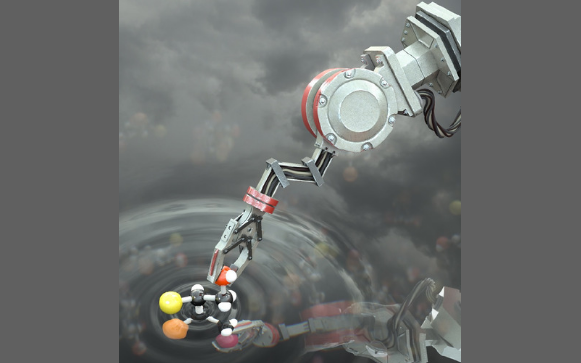Molecular Robotics Builds the Ultimate Miniature Machines
In the decades to come, the U.S. military may manufacture combat parts and supplies on the battlefield using robots made of molecules all working together as part of a molecular factory. The nanoscale factories could revolutionize military logistics by eliminating the need to transport or store parts and supplies for every possible contingency. The same technology may prove useful for tying together strands of molecules for superstrong, lightweight armor.
Researchers at the University of Manchester in England have developed the first prototypes for robots made entirely of atoms, the building blocks of molecules. Molecules form the basis of everything on the planet and the planet itself, for that matter. The molecular robots—mobots?—are a millionth of a millimeter in size, meaning that a pile of a billion billion such robots would be the same volume and weight as a few grains of salt, according to a press release announcing the breakthrough. Each robot is made up of just 150 carbon, hydrogen, oxygen and nitrogen atoms and is capable of manipulating a single molecule. The robots can be programmed to move and build molecular cargo.
They operate by carrying out chemical reactions in special solutions, which can then be controlled and programmed by scientists to perform basic tasks. David Leigh, Royal Society research professor and Sir Samuel Hall chair of chemistry, University of Manchester, explains that robots in “the big world” may use fingerlike devices for gripping, but molecular robots use an atom, such as sulfur. “It’s sort of a sticky atom, if you like—an atom that can be made sticky or nonsticky. It can be sticky to pick something up, and then you can change the electronic properties of the atom to make it release, so you can grip and release,” Leigh says. “You can use electrostatics. You can make it charged to pick up something of the opposite charge, and then if you stop it being charged, it will drop it.”
One possibility for programming the itty-bitty bot is to switch it back and forth from acidic to nonacidic or basic. “If we give it a sequence changing the acidity of the environment the robot is in, we switch it between acidic and then basic and then acidic and then basic—acid and nonacid—it will do one thing. If you change that and leave your acid for longer, and then change the acidity again, it will do something different. That’s chemical programming,” he adds.
The result may be to switch the gripper on and off, or to twist the arm to point in one direction or another, or to pick up or put down cargo. “It’s those sorts of operations that are controlled by chemical stimuli. Or there are other sorts of stimuli we can use. We can use lights. We can use electrochemistry. It’s exactly the same principle. You program it in the same way you program a robotic arm in the big world. It’s just that it’s not using a code from a computer. It’s using a different way of interrogating the arm,” Leigh elaborates.
Building big-world objects with molecular robots is simply a matter of connecting the necessary molecules. After all, everything on the planet is made of molecules. “Molecules are made of atoms assembled together like Lego blocks. Just like you can make machines—cars and trains and pulleys and things like that—out of Legos, that’s what molecular machines look like,” Leigh offers.
But it’s really not that easy because big-world physics does not work in the molecular world. Building a molecule-size car, for example, is impossible. “Something like a gas engine simply can’t function at the molecular-length scale because heat is immediately dissipated, so you can’t build motors based on heat transfer. You can’t just shrink down the motorcar to the molecular world,” he notes.
Leigh’s team announced last year the first-ever molecular robot, but the research has been going on for about 20 years and is still in its infancy. To make the robot work, the researchers studied nature’s molecular machines. “There are already working nanotechnology machines. That’s called biology,” Leigh says. “The way the cell works and the way that life works is that all the biological processes are actually run by molecular machines, but they’re all biological. They’re proteins, but they’re working just like machines do in the big world.”
Researchers indicate that the technology could one day offer a range of benefits in a variety of fields, including medical and military. The robots may be able to manufacture medicines or antidotes for chemical or biological warfare agents. “You could make antidotes for all sorts of nefarious or noxious agents. You wouldn’t need to carry with you all sorts of antidotes. Your molecular factory could just manufacture the antidote for the poison gas or whatever the substance was,” Leigh suggests.
On-demand manufacturing of parts and supplies is another possibility, a capability similar to today’s 3D printing. Military forces operating in remote places such as Afghanistan or the Arctic would not need to transport tons of supplies. “If you’re in the Arctic and you can’t get supplied with lots of different drugs, and you fall ill from pneumonia, you could use these to manufacture just the drug you want,” Leigh theorizes.
Strong, lightweight and flexible armor is another possibility. The University of Manchester team is receiving some funding from the Defense Advanced Research Projects Agency (DARPA) in the United States to explore the possibility of using the same technology to develop advanced materials. “The same technology we use for molecular machines we also use to weave molecular fabrics. We have a DARPA grant that’s to do with weaving molecular fabrics, which could be useful for making very strong, very lightweight materials,” Leigh reports.
Currently, no process exists for weaving molecular strands. Today’s armor relies instead on molecular strands lined up side by side “like pencils in a pencil case,” Leigh adds. “Those rigid rods are then twisted into fabrics. We’re trying to weave the individual strands themselves.”
Anne Fischer, a program manager in DARPA’s Defense Sciences Office, confirms the agency is providing funding for the research. “One of the areas professor Leigh’s group studies is molecular knots. These are precisely entangled molecules that form structures resembling knots: for example, the Celtic knot,” Fischer reveals in a written response to questions. “His work with DARPA is an extension of this concept, with a goal to chemically stitch molecular knots together in a two-dimensional woven structure.”
Those molecular knots may offer benefits beyond advanced armor. “Two-dimensional materials like graphene, boron nitride and molybdenum disulfide have attractive properties for a number of applications, including high-strength materials, electrical components or filtration membranes,” Fischer adds.
So far, however, the materials are not sophisticated enough to reach their full potential. “These materials are made of relatively simple building blocks—the atoms themselves. In contrast, the unit cell of the interwoven material in Leigh’s work is the molecular knot itself. These materials could enable tremendous variety in material architecture and potentially properties just by adjusting the knotted building blocks,” Fischer offers. “The Leigh group has pioneered work on molecular knots, and this exploratory effort is testing whether and how those knots can be connected in a two-dimensional array to ultimately realize tunable and desirable material properties.”
It is far too early to say with any certainty what the final results of the research might be, but Leigh hints that they could be revolutionary. “The ability to weave materials brought Stone Age man out of the cave because he was able to suddenly weave fabrics and keep himself warm. This could have similar effects. That’s what we think. Until we make them, we don’t know,” Leigh acknowledges.
The potential benefits go far beyond the military, however. In addition to producing medicines and antidotes, molecular robots could help cure diseases caused by genetic disorders. The National Human Genome Research Institute lists nearly 50 such disorders, including autism, various cancers, cystic fibrosis and Parkinson’s disease. “We could one day perhaps replace those [genes] with artificial ones. It would be like molecular prosthetics,” Leigh says. “Using a molecular prosthetic may enable a disease to be cured.”
He stresses that the research has a long way to go. A prosthetic hand once consisted of a simple hook with severely limited function, but now mechanical fingers and opposable thumbs are realities. Genetic prosthetics also will need time to evolve in the same way “that prosthetics in the big world are getting better and better, and people are getting artificial hands that can really grip. We can see that will happen one day with molecular prosthetics, and we will be able to replace biological machines even with artificial molecular machines that are just as good,” Leigh explains.
Other results of the research may be less important than the possibility of curing cancer but still fun to ponder. They could potentially lead to programmable desktops—as in the top of a desk, not computers. Today’s desktop may be made of wood or any number of other materials, all of which are made of molecules, and its only function is to hold a computer, a mouse, a coffee cup and other objects. “If it was covered in a layer of molecular machines that could switch their properties, they might be able to switch the surface from being sticky to nonsticky, or they might be able to switch the surface from being hard to flexible, or they might even enable me to pass the coffee cup on the table toward me just by drawing a light with a laser pointer instead of my having to reach over and pick it up,” Leigh proposes. “It could just pass along the coffee cup from machine to machine, just like a moving stairway or moving walkway.”
Many of the technological advances in recent decades have been a result of machine miniaturization. Computers have become smaller but far more powerful. The chip inside a cellphone has more processing power than a room-size computer in the 1950s, Leigh notes. And it’s hard to get more miniature than molecules. “The same will be true of molecular robotics to build things. You will require far less energy than you need for the factories that we use today,” Leigh asserts. “Building machines out of molecules is the ultimate in miniaturization.”







Comments